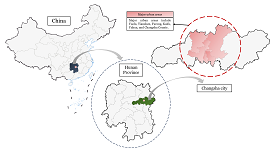
Asia Pacific Academy of Science Pte. Ltd. (APACSCI) specializes in international journal publishing. APACSCI adopts the open access publishing model and provides an important communication bridge for academic groups whose interest fields include engineering, technology, medicine, computer, mathematics, agriculture and forestry, and environment.

As China's pillar industry, the property market has suffered a considerable impact in recent years, with a decline in turnover and many developers at risk of bankruptcy. As one of the most concerned factors for stakeholders, housing prices need to be predicted more objectively and accurately to minimize decision-making errors by developers and consumers. Many prediction models in recent years have been unfriendly to consumers due to technical difficulties, high data demand, and varying factors affecting house prices in different regions. A uniform model across the country cannot capture local differences accurately, so this study compares and analyses the fitting effects of multiple machine learning models using February 2024 new building data in Changsha as an example, aiming to provide consumers with a simple and practical reference for prediction methods. The modeling exploration applies several regression techniques based on machine learning algorithms, such as Stepwise regression, Robust regression, Lasso regression, Ridge regression, Ordinary Least Squares (OLS) regression, Extreme Gradient Boosted regression (XGBoost), and Random Forest (RF) regression. These algorithms are used to construct forecasting models, and the best-performing model is selected by conducting a comparative analysis of the forecasting errors obtained between these models. The research found that machine learning is a practical approach to property price prediction, with least squares regression and Lasso regression providing relatively more convincing results.
Cultural diversity, entrepreneurship and urban trade competitiveness—Empirical evidence of urban panel data in China
Vol 2, Issue 1, 2021
Download PDF
Abstract
Based on the reality of large-scale population mobility brought about by China's urbanization, using the panel data of 268 cities in China in 2012 and 2018, this paper constructs urban cultural diversity indicators from the perspective of labor source, and studies the impact of cultural diversity on urban trade competitiveness and its mechanism Research findings: Cultural diversity and urban trade competitiveness show an inverted "U" relationship The impact of cultural diversity on the trade competitiveness of different cities is different. The administrative level of the city and whether the city is coastal will affect the effect of cultural diversity on the city's trade competitiveness Entrepreneurship is an intermediary variable between cultural diversity and urban trade competitiveness. Specifically, it affects urban trade competitiveness through two channels: entrepreneurial innovation and entrepreneurial entrepreneurship The above results have brought important enlightenment to the interpretation of the relationship between cultural diversity and urban trade competitiveness
Keywords
References
- Chen S, Liu H. Demographic dividend, urbanization and the development of China’s export trade. International trade issues. 2013; (6).
- Schott PK. The relative sophistication of Chinese exports. Economic Policy. 2007; 23(53): 5-49. doi: 10.1111/j.1468-0327.2007.00195.x
- Cai F. How long can China's demographic dividend last. Economic trends. 2011; (6).
- Zhang C. Foreign human capital, cultural diversity and Chinese urban innovation. World economy. 2019; (11).
- Ottaviano GIP, Peri G. Cities and cultures. Journal of Urban Economics. 2005; 58(2): 304-337. doi: 10.1016/j.jue.2005.06.004
- Lazeare EP. Culture and Language. Journal of Political Economy. 1999; (56).
- Alesina A, Ferrara EL. Who trusts others? Journal of Public Economics. 2002; 85(2). doi: 10.1016/S0047-2727(01)00084-6
- Hong L, Scott EP. Problem solving by heterogeneous agents. Journal of Economic Theory. 2001; (1).
- Qian H. Diversity Versus Tolerance: The Social Drivers of Innovation and Entrepreneurship in US Cities. Urban Studies. 2013; 50(13): 2718-2735. doi: 10.1177/0042098013477703
- Fabling R, Sanderson L. Entrepreneurship and aggregate merchandise trade growth in New Zealand. Journal of International Entrepreneurship. 2010; 8(2): 182-199. doi: 10.1007/s10843-010-0063-9
- Cumming D, Johan S, Zhang M. The Economic Impact of Entrepreneurship: Comparing International Datasets. Corporate Governance: An International Review. 2014; 22(2): 162-178. doi: 10.1111/corg.12058
- Muñoz-bullón F, Sánchez-bueno M J, Vos - saz A. Nascent entrepreneur's personality attributes and the international dimension of new ventures. International Entrepreneurship and Management Journal. 2015; 11(3).
- Yang HYO, Chaisingharn N, Nguyen TH. The impacts of entrepreneurship on export orientation and internationalisation: the moderating effects of family ownership and involvement. International Journal of Innovation and Learning. 2016; 19(1): 1. doi: 10.1504/ijil.2016.073284
- Shi B, Shao W. Measurement of export product quality of Chinese enterprises and its determinants -- A micro perspective of cultivating new export competitive advantages. Management world. 2014; (9).
- Khandelwal AK, Schott PK, Wei SJ. Trade Liberalization and Embedded Institutional Reform: Evidence from Chinese Exporters. American Economic Review. 2013; 103(6): 2169-2195. doi: 10.1257/aer.103.6.2169
- Wei S, Yang Y, Chen L. Urban hierarchy, population growth difference and evolution of urban system. China's industrial economy. 2020; (7).
- Wei H. Administrative hierarchy and scale growth of Chinese cities. Research on cities and environment. 2014; (1).
- Hébert RF, Link AN. In search of the meaning of entrepreneurship. Small Business Economics. 1989; 1(1): 39-49. doi: 10.1007/bf00389915
Supporting Agencies
Copyright (c) 2021 Jiayue Liu, Ying Hu

This work is licensed under a Creative Commons Attribution 4.0 International License.

This site is licensed under a Creative Commons Attribution 4.0 International License (CC BY 4.0).

Prof. Mehmet Cetin
Kastamonu University,
Turkey
Polish Scientific Bibliography

